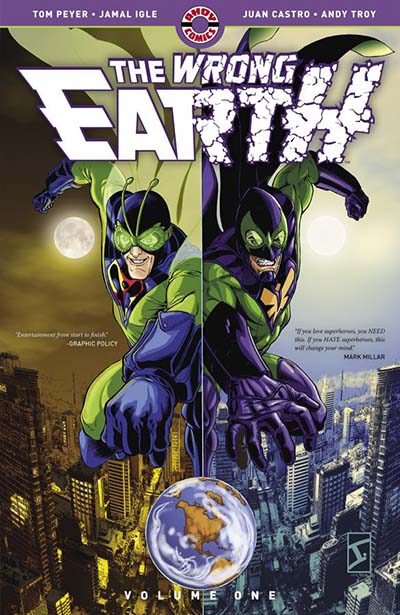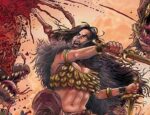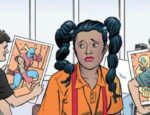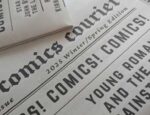With titles like Billionaire Island, Second Coming, The Wrong Earth and G.I.L.T. AHOY Comics have been leading the way in putting the fun back into serial comics over the last few years, albeit with a deliciously dark and satirically comedic edge. On the occasion of the publisher’s fifth anniversary this year we had a long overdue chat with AHOY’s Tom Peyer and Stuart Moore about their publishing ethos, changing trends in comics, and just where the name AHOY came from…

The Wrong Earth: We Could Be Heroes #1 cover by Jamal Igle
ANDY OLIVER: So AHOY Comics is five years old this year. Let’s start with the obvious opening question and ask you about the genesis and founding of AHOY and your own backgrounds in the industry. And what was behind the choice of the name AHOY?
TOM PEYER: Since his college days, our publisher Hart Seely has organized a secular holiday get-together most every December, during which revellers in various stages of what we’ll call “refreshment” vote for the A.H.O.Y., which stands for Asshole of the Year. The winner has to be someone nationally or globally famous; no punching down. Past honorees include Donald Rumsfeld, OJ Simpson, and Sylvester Stallone. AHOY CCO Frank Cammuso and I were long pressed into service to design and contribute jokes for ballots, announcements of the results, etc. When he, Hart, and I were struggling to put a name on the company, and Frank finally shouted “AHOY Comics,” we stopped thinking about the problem in that very second. We had our name.

The Wrong Earth: We Could Be Heroes #1 alt cover by Jon Proctor
AO: How would you describe AHOY’s publishing ethos? What kind of genres and approaches to the page do you exist to champion?
TOM: We’re flexible when it comes to genre. AHOY’s prime directive is, everything we publish has to be funny on some level. They don’t have to be comedies, but they can’t be humorless. Unless that’s the joke.
STUART MOORE: Tom and I both worked on DC’s Vertigo imprint, in its early days. Our internal shorthand for AHOY is “Funny Vertigo.” Of course, Vertigo was pretty funny too, but people tend to forget that.

Second Coming Vol 1 cover by Richard Pace
AO: Super-heroes are a notable part of your output but always with an extra twist. It’s a genre that seems to have been going through yet another dark and gritty phase elsewhere in recent years. Is putting the fun back into super-heroes a big part of your thinking with those books?
TOM: It’s more that we look for wrinkles that haven’t been done, or done much. And ideas that are amusing in and of themselves. Second Coming, which pits the virtue and power of the world’s greatest superhero against that of Jesus Christ, is a perfect example. When we do a superhero story—and I love them—the question “will the hero defeat the villain?” is usually the farthest thing from our minds.
STUART: One of AHOY’s first books was Tom and Jamal Igle’s brilliant The Wrong Earth, which returns in October. That was designed as a very direct take on superheroes, but I think it’s fair to say the company’s scope is much broader than that.
Billionaire Island covers by Steve Pugh and Pia Guerra
AO: Social commentary is at the heart of a number of AHOY books, particularly where writer Mark Russell – who I have certainly come to think of as the Steve Gerber of his generation – is concerned. Why do you think that satirical comics are such a powerful storytelling form for that kind of commentary in terms of the connections they make with readers in communicating those themes?
TOM: Well, things get so depressing that, if you can find a way to think about them that’s more or less amusing, I think it helps. You can maybe face the troubles a little more bravely, or at least get through the day.
STUART: Steve Gerber’s Howard the Duck helped me get through age 15, so I’m definitely on the same page with this. Mark has a wonderful way of distilling a complex social or political problem down to a short quip that stays with you, long after you read it.

Project: Cryptid #1 alt cover by Taki Soma
AO: It’s your 5th publishing anniversary this year. What have been some of the highlights of those first five years for you, and what do you have planned to celebrate?
TOM: I’m proud of everything we’ve published. One highlight for me was our Edgar Allan Poe project: Four volumes of short, funny horror stories by various creators. We got to work with so many great people. So we’re kicking the fifth anniversary off with a new anthology, Project: Cryptid. We’ve commissioned a zillion of the finest creators to tell stories, of Bigfoot, the Loch ness Monster, and all of the other strange creatures that some people actually believe in. That launches September 6. Beyond that we’re going to revisit Jamal Igle’s and my The Wrong Earth and Stuart Moore & June Brigman’s Captain Ginger, two of AHOY’s original titles, in two-issue micro-miniseries. And there’s more to look forward to beyond that. Plus, we’re doing this maniacal prose-story project, but it’s Stuart’s baby, so I’ll let him tell you.

Bronze Age Boogie cover by Alberto Ponticelli
STUART: Why, thank you…on a whim I emailed Grant Morrison, who helped launch AHOY five years ago, and asked them if they’d be interested in writing a short prose piece that could serve as a first chapter to a multi-author serial, designed to run throughout the AHOY line this fall. Grant promptly sent me Part One of
THE ALL-STAR ANNUALLY CONVENING COZY DETECTIVES CLUB
in
PARTIALLY NAKED CAME THE CORPSE!
which was funnier, more brilliant—and longer—than I could have imagined, with Grant’s usual surreal flare. That story appears in the back of Project: Cryptid #1, and there’s a full list of the other authors and installments at the link here.

Captain Ginger: The Last Feeder #1 cover by June Brigman
AO: Just as you were building up a real buzz around your titles in 2020 we were hit by the pandemic. How did you have to adapt and evolve to deal with the challenges that brought?
TOM: We just made it up as we went along and tried to stay adaptable; I think more-or-less everyone had to do that.
STUART: Yeah, we tried some things that worked and some things that didn’t, like going digital-only on one title. Diamond suspended shipments for a while; that was kind of an existential event (though I don’t blame them at all—they had employees to think about), so for a few months we weren’t sure what was going to happen. Life went on, eventually.

Captain Ginger: The Last Feeder #1 alt cover by Walt Simonson
AO: You’re both veterans of periodical comics publishing. What have been the biggest changes in that side of the industry in your time working in it? Has your adoption of the “Season” format for your books been a reaction to that?
TOM: The technological changes have been vast; we used to use things like paper clips and folders. And my desk at DC in the dawning days of Vertigo had a typewriter, an ashtray, a landline, and nightmarishly chaotic stacks and avalanches of paper. It took longer to put out a comic book, and the process was messier. You could stain your clothes.
As far as the business side of things goes, I am the worst person you can ask. But our “Seasons” or “Waves” were primarily intended as a way to avoid late ships. We have most of the work in-house before publishing, then create spaces on the schedule where we can stock up again.
STUART: Yeah, now Tom has no excuse for the stains on his clothes.
I love the fact that, as a writer, I can collaborate with an artist anywhere and just throw notes and images back and forth at will. It’s something younger creative people just take for granted. The turning point was my time on staff at Marvel Knights in the early 2000s. I remember thinking, “It’s THIS easy to make a comic book?” Of course, making a good one is still the trick.

Edgar Allan Poe’s Snifter of Blood Vol. 1 cover by Alan Robinson
AO: Following on from that, something I know I really miss in periodical comics is the self-contained issue, which is largely non-existent now given that most serial comics are written in story arcs with a trade collection in mind. Was giving readers something immediately accessible that they could dip into without previous knowledge behind projects like the various Edgar Allan Poe books and the upcoming Project: Cryptid?
TOM: Absolutely. I love the one-offs, too. But outside of anthologies, the comics world has pretty much moved on from them. I’ve been thinking about Star Trek: Strange New Worlds as a possible way back. They do such an excellent job of telling one-off stories that contain a kernel of full-season arc, enough to keep you coming back. And, if I’m not mistaken, they’re doing something like that in Fantastic Four right now. I need to read that.
STUART: It’s tough because (a) modern entertainment has trained its audience to want bigger and bigger spectacle and (b) there’s so much entertainment competing for people’s attention right now that you need to pull them back for one installment after the other, or you lose them—and that’s harder to do with self-contained stories. But I agree that Strange New Worlds has the formula down; so do the Marvel films, actually. It helps to write good stories with characters people care about.

The Wrong Earth Vol. 1 cover by Jamal Igle
AO: As I have you both here it would be remiss not to ask you about your own AHOY projects. What have you been most proud of to date and what will you be working on next?
TOM: If you’re kind enough to draw my comics, I could never make a list of favorites and leave you off. But I’m pleased to be back working on The Wrong Earth with Jamal, Juan Castro, Andy Troy, and Rob Steen.
STUART: Ditto for Captain Ginger: The Last Feeder, which begins in November—cats in space! June Brigman! My series Highball, which came out recently in trade paperback, is a sort of political-themed space-adventure farce; I think it’s the only comic ever to use a real memo from Amazon publishing as the climax to an issue. Bronze Age Boogie tends to get lost in the conversation, but people still come up to me at conventions and tell me how much they loved it.

Highball Vol. 1 cover by Fred Harper
AO: AHOY’s range has become known for its inclusion of back matter including short stories and poetry. What was the thinking behind running that extra material?
TOM: When we were trying to figure out what makes an AHOY book, we’d look at editorial packages from the dawn of comics to the present. And one thing that recurred until the mass arrival of letters’ pages in the ’50s and ’60s were these short text stories. They seemed to be written very fast by writers who worked very cheap; I don’t know if I ever was able to finish reading one. But, we thought, “What if these were good?” So we gave it a try, and it’s really worked out. It’s a way to give you your money’s worth. We’d like one or two AHOY comics to last your whole lunch hour.
STUART: I’ve written several of them and they’re a remarkable way to experiment with prose styles and subject matter. I’ve written existential horror, space opera, slice of life, meditations on writing; my first piece was almost a tone poem based on listening to conductors and flight attendants non-stop during a busy month of travel. I love that there’s room for all of that.
G.I.L.T. #1 cover by Mauricet
AO: And, finally, what can we expect in the near future from AHOY? From upcoming books like Con & On through to your 2024 schedule?
TOM: If I tell you, they’ll kill me.
STUART: Tom covered a lot of it above. There will be some surprises in 2024, some new voices that will stretch the range of the AHOY line. Plus more goofy jokes and funny illustrations. And a lot of cryptids!
For more on AHOY Comics visit their website here.

















